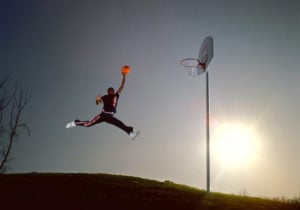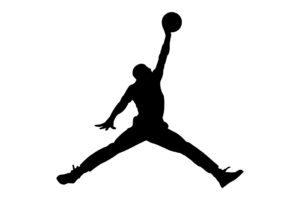What is copyright and how is it different from a trademark?
Copyright is the exclusive legal right to produce, reproduce, publish or perform an original literary, artistic, dramatic or musical work. You could have a copyright on your song, manuscript, novel, theatre play, a photograph, a webpage, etc. Even a logo is eligible for copyright but only if there is a certain higher level of creativity involved. A copyright prevents and protects you from others copying your work.
A lot of people confuse copyright with a trademark. Copyright differs from a trademark in a way that a trademark protects items that consist of a company brand. You could trademark your trade name, logo, company slogan etc. generally when it is used on the goods and services you’re selling. A trademark only protects against use of a mark that causes confusion in the trademark owner’s market.
How did a flying Michael Jordan get involved in a dispute on copyright?

Photo from LIFE in 1984, Jacobus “Co” Rentmeester
Nike has prevailed in a law suit over copyright infringement on Michael Jordan’s jumpman photograph.
In 1984, photographer Jacobus Rentmeester took a photo for Life Magazine of Michael Jordan, gliding toward an outdoor basket with his legs wide open while holding a ball in his outstretched left hand.
Later in 1984, Michael Jordan signed a deal with Nike. Nike conducted a campaign for the “Air Jordan” brand, using also a photo of Michael Jordan jumping towards the basketball ring while obviously wearing Nike shoes. When Rentmeester threatened to sue Nike for violating copyrights on his photo, Nike paid him $15,000 to use the photo for certain marketing purposes for 2 years. In 1987 Nike created the “Jumpman logo” which is still used as a logo on shoes and all kinds of sporting gear until today and has become one of Nike’s most well-known trademarks.

In 2015 Jacobus Rentmeester filed a lawsuit against Nike for copyright infringement. Rentmeester argued that Nike infringed his copyright in this photograph of Michael Jordan when it commissioned its own photograph of Jordan and then used that photo to create its “Jumpman” logo. According to Rentmeester the distinctions between his and Nike’s images were minor, and all the original elements were copied by Nike. Nike argued that Rentmeester “cannot claim copyright over the “idea” of Michael Jordan dunking a basketball.” The Appeals court ruled that there is no copyright infringement by Nike – the two photographs are not “substantially similar” since there were objective differences in selection and arrangement of elements between the two photos. Specifically, the court held that the pose itself was not eligible for copyright protection and that protection could only be obtained for the way the pose was expressed, including the camera angle, timing, and shutter speed chosen.
Rentmeester appealed to the Supreme Court, but they refused to hear his case. The Supreme Court therefore did not take the opportunity to clarify the limits for when elements of a photo need copyright protection.
How would Canada look at the copyright on Michael Jordan’s photographs?
According to the Canadian Copyright Act, you are infringing copyright if you are reproducing the work of the copyright owner in its entirety or for a “substantial part” thereof. The Canadian Supreme Court noted in the case Cinar Corporation v Robinson that “substantial” is a “flexible notion”, which is “a matter of fact and degree”. A qualitative and holistic approach must be adopted to assess this (i.e. all the copied features must be considered cumulatively). and a piecemeal approach should be avoided. However, if differences are so great that the work viewed as a whole is not an imitation but rather a new and original work, then there is no infringement.
So, following this assessment of “substantial part”, little parts of the work, such as quotes could in many cases may be replicated without penalty. You should also check whether a critical portion of the work was reproduced rather than a more negligible part.
This assessment of “substantial part” in the framework of copyright infringement in Canada seems to be quite different from the one made in the US judgement in the case Nike-Rentmeester. According to this last case you now apparently need to only change a few aspects of a photo to be legally protected as far as copyright goes, while according to Canadian standards a holistic approach needs to be applied to determine whether there is copyright infringement. The chances are therefore rather low that a Canadian court would automatically not include the jumpman pose on the photograph from copyright protection, especially when the copyright owner told Michael Jordan which pose to take.
What actions could you undertake to protect yourself against copyright infringement of your work?
- Place the © symbol next to the original work together with the name of the copyright owner and the year the copyright was firstly published. This will discourage people from copying your work.
- Consider registering copyright with the competent Intellectual Property Office. Although not mandatory in many countries (including Canada and the US), registration creates a public record and gets you a certificate that you can use in court as evidence that you own the registered work. In the US copyright registration is even a prerequisite to obtain certain damages following infringement from a work.
This article was published more than 1 year ago. Some information may no longer be current.

